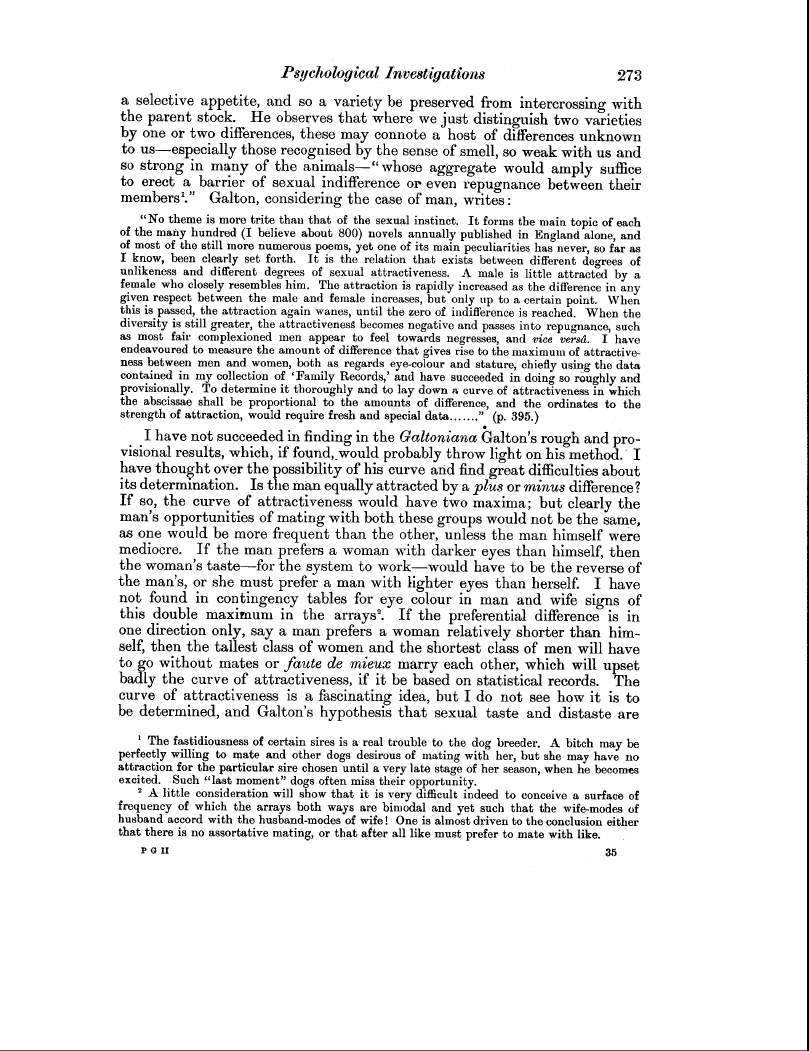Psychological Investigations 273
a selective appetite, and so a variety be preserved from intercrossing with the parent stock. He observes that where we just distinguish two varieties by one or two differences, these may connote a host of differences unknown to us-especially those recognised by the sense of smell, so weak with us and so strong in many of the animals-"whose aggregate would amply suffice to erect a barrier of sexual indifference on even repugnance between their members"." Galton, considering the case of man, writes
"No theme is more trite than that of the sexual instinct. It forms the main topic of each of the many hundred (I believe about 800) novels annually published in England alone, and of most of the still more numerous poems, yet one of its main peculiarities has never, so far as
I know, been clearly set forth. It is the relation that exists between different degrees of unlikeness and different degrees of sexual attractiveness. A male is little attracted by a female who closely resembles him. The attraction is rapidly increased as the difference in any given respect between the male and female increases, but only up to a certain point. When this is passed, the attraction again wanes, until the zero of indifference is reached. When the diversity is still greater, the attractiveness becomes negative and passes into repugnance, such as most fair complexioned men appear to feel towards negresses, and vice versa. I have endeavoured to measure the amount of difference that gives rise to the maximum of attractiveness between men and women, both as regards eye-colour and stature, chiefly using the data contained in my collection of `Family Records,' and have succeeded in doing so roughly and provisionally. To determine it thoroughly and to lay down a curve of attractiveness in which the abscissae shall be proportional to the amounts of difference, and the ordinates to the
strength of attraction, would require fresh and special data " (p. 395.)
I have not succeeded in finding in the Galtoniana Galton's rough and provisional results, which, if found,_ would probably throw light on his method. I have thought over the possibility of his curve and find great difficulties about its determination. Is the man equally attracted by a plus or minus difference? If so, the curve of attractiveness would have two maxima; but clearly the man's opportunities of mating with both these groups would not be the same, as one would be more frequent than the other, unless the man himself were mediocre. If the man prefers a woman with darker eyes than himself, then the woman's taste-for the system to work-would have to be the reverse of the man's, or she must prefer a man with lighter eyes than herself. I have not found in contingency tables for eye colour in man and wife signs of this double maximum in the arrays. If the preferential difference is in one direction only, say a man prefers a woman relatively shorter than himself, then the tallest class of women and the shortest class of men will have to go without mates or faute de mieux marry each other, which will upset badly the curve of attractiveness, if it be based on statistical records. The curve of attractiveness is a fascinating idea, but I do not see how it is to be determined, and Galton's hypothesis that sexual taste and distaste are
' The fastidiousness of certain sires is a real trouble to the dog breeder. A bitch may be perfectly willing to mate and other dogs desirous of mating with her, but she may have no attraction for the particular sire chosen until a very late stage of her season, when he becomes excited. Such "last moment" dogs often miss their opportunity.
2 A little consideration will show that it is very difficult indeed to conceive a surface of frequency of which the arrays both ways are bimodal and yet such that the wife-modes of husband accord with the husband-modes of wife ! One is almost driven to the conclusion either
that there is no assortative mating, or that after all like must prefer to mate with like.
P a 11 35

